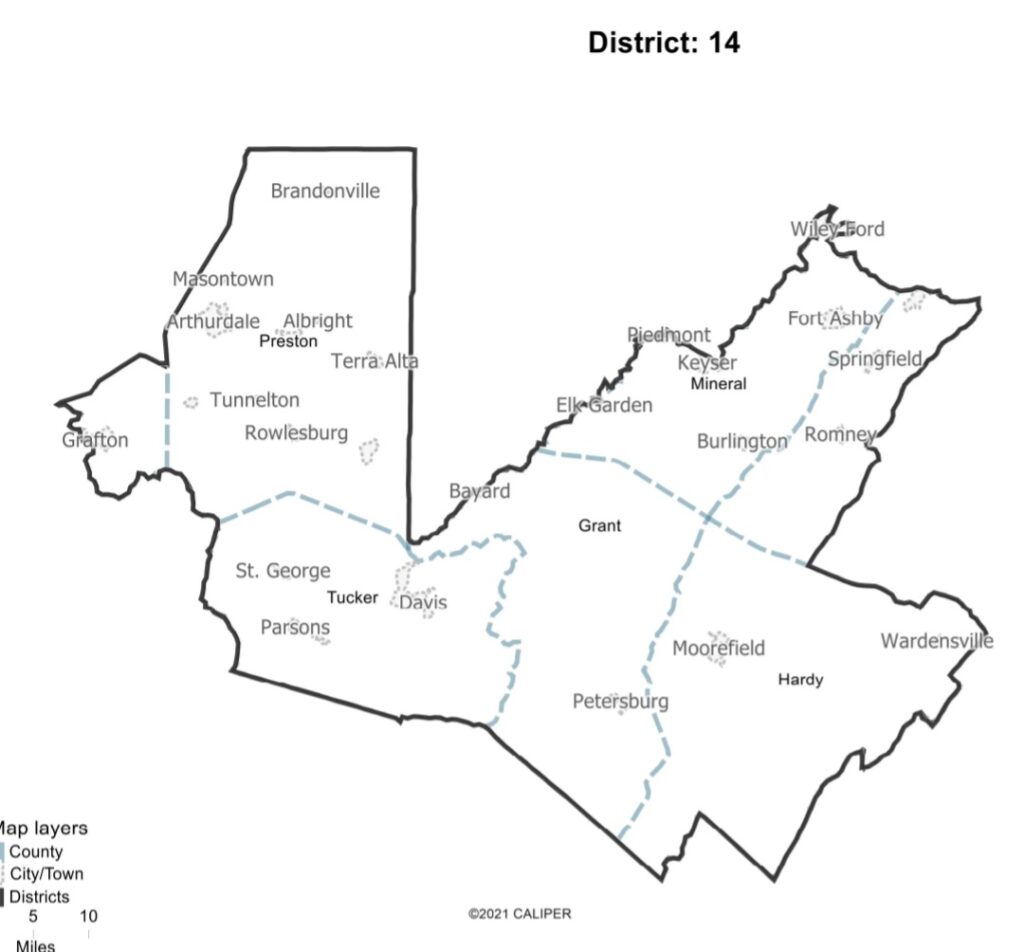CHARLESTON — The House of Delegates on Thursday approved the Congressional map sent over from the Senate. Final action on the other two — the House district map and Senate district map — will be delayed until Friday, at least.

The much-buzzed-about alternate Senate map is in the system in the form of a floor amendment, but senators said haggling continued. On the floor, action on the bill containing the Redistricting Committee map, SB 3034, was delayed for a second time; the bill will again be on third reading and subject to amendment on Friday.
The proposed amendment differs substantially from the committee map.
For instance, on the committee map, Monongalia and Cabell counties are whole; Wayne County is in District 6 with Lincoln, Boone and Logan. On the amendment, Mon is divided in much the same way as on the current map, with Morgantown and Fairmont linked in the 13th and western and northern Mon in the 2nd — though Westover and Granville are moved into the 2nd.
Cabell is split across two districts on the amendment and Wayne is joined with Mingo and parts of McDowell and Mercer.
Hallway talk calls the amendment the Karnes map, after Sen. Robert Karnes, R-Randolph.

But after the Thursday floor session, Karnes declined to take credit for it. “I think it’s a product of the caucus,” he said. “As far as I’m concerned, it’s a caucus map.”
The redistricting committee, he said, put out a plan that didn’t necessarily have the full support of the caucus.
Given that this is the GOP’s first go at redistricting in nearly a century, he said, “We’re trying to be as thorough as we can be, and considering all the possible variations and the full implications of what those variations are, we gave it one more day.”
Responding to the comment that it veers further from the Constitutional mandate to keep counties whole than the committee map, Karnes said it comes closer to the mandate for district compactness.
“In some cases it’s more compact if the county is split,” he said.
He also believes, he said, that the amendment more respects communities of interest. In his district for instance, residents of the northern half of one of his counties leave the county to shop at one place, and the southern residents leave to shop at another place. Neither group is focused on their county.

They’ve learned things like that, which the person drawing lines with the mapping software wouldn’t know, he said.
Sen. Mike Caputo, D-Marion, is a Redistricting Committee member but voted against the committee map, in part because it put Marion in a district with Wetzel, Tyler and Doddridge — counties it has little in common with, he’s said previously.
On Thursday, he said talks are ongoing. “It’s really my hope that the majority party will work with us and try to come up with a compromise. This process should not be hard-core political; it should be more about the voters than us.”
Caucus staff have been working long hours on the maps, he said, and Democrats have proposed some tweaks.
“We went all around the state talking to people about this, and there were a lot of things put on the table, but fairness was always at the top of that list, and transparency was always at the top of that list. Let’s hope we get there.”
At the end of the day, he said, “I want to feel good about a map. I want to vote for a map. And I do not want a map to pass this body on party lines.”
Congressional map
The House passed SB 3033, the Congressional map bill, in an 84-12 vote.

While it’s a Senate bill, the map is actually the House map. The Senate and House maps differed by only two counties so the Senate amended its to match the House version and passed it on Wednesday.
Because of the state’s population loss, the state will have two Congressional districts instead of three. District 1 is the southern district, with the top border being Jackson, Wirt, Calhoun, Gilmer, Braxton, Webster, Pocahontas, and Pendleton counties.
District 2 contains both panhandles and the state’s two Congressmen who come from the panhandles — Republicans David McKinley and Alex Mooney — will have to face each other in the 2022 primary. Rep. Carol Miller is from Cabell County and won’t face an incumbent opponent.
All 12 votes against came from Democrats. Mon County’s four Democratic delegates all voted no: Barbara Evans Fleischauer, Evan Hansen, Danielle Walker, and John Williams. Mon Republican Joe Statler was not present for the vote.
TWEET David Beard @dbeardtdp
EMAIL dbeard@dominionpost.com




